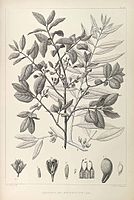
Fokienia is a genus of conifer tree belonging to the cypress family. In its characteristics, Fokienia is intermediate between the genera of Chamaecyparis and Calocedrus. Genetically Fokienia is much closer to Chamaecyparis, and not all researchers recognize Fokienia as a separate genus. The genus comprises only one living species, Fokienia hodginsii or Fujian cypress, and one fossil species.

Juniperus excelsa, commonly called the Greek juniper, is a juniper found throughout the eastern Mediterranean, from northeastern Greece and southern Bulgaria across Turkey to Syria and Lebanon, Jordan, the Caucasus mountains, and southern coast of Crimea.
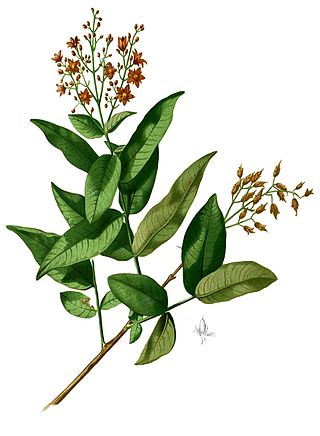
Cratoxylum is a genus of flowering plants in the family Hypericaceae, native to tropical Asia. The generic name means "strong wood", referring to the timber.
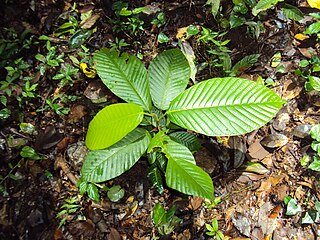
Dipterocarpus is a genus of flowering plants and the type genus of family Dipterocarpaceae.

The Amboina box turtle or Southeast Asian box turtle is a species of Asian box turtle widely distributed across Southeast Asia. Its range extends on the Asian mainland from northeast India, through Bangladesh, Burma and Thailand, across Laos, Cambodia, Vietnam, and Malaysia. It is also found on the archipelagos of Indonesia and the Philippines.

Pterocarpus macrocarpus, or Burma padauk, is a tree native to the seasonal tropical forests of southeastern Asia: in Myanmar, Laos, Cambodia, Thailand, and Vietnam. It has been naturalized in India and the Caribbean.

Dalbergia oliveri is a species of legume in the family Fabaceae which grows in tree form to 15 – 30 meters in height. The fruit is a green pod containing one to two seeds which turn brown to black when ripe. It is threatened by habitat loss and over-harvesting for its valuable red "rosewood" timber.

Cratoxylum arborescens is a plant in the family Hypericaceae. The specific epithet arborescens is from the Latin meaning "tree-like".
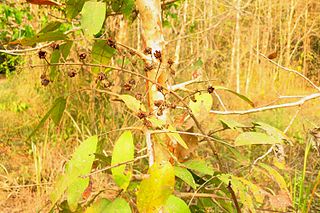
Cratoxylum cochinchinense is a plant now placed in the family Hypericaceae. The specific epithet cochinchinense is from the Latin meaning "of Cochinchina". In Vietnamese C. cochinchinense is usually called thành ngạch nam or lành ngạnh nam, other names include: hoàng ngưu mộc, hoàng ngưu trà and đỏ ngọn.
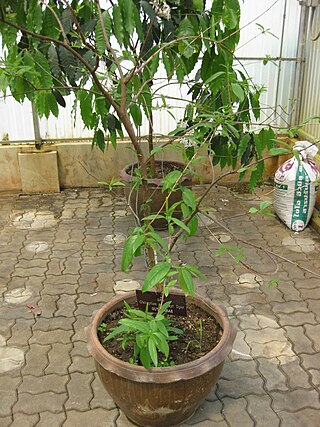
Cratoxylum maingayi is a plant in the family Hypericaceae. It is named for the botanist Alexander Carroll Maingay.

Hypericum socotranum is a species of flowering plant in the Hypericaceae family which is endemic to the island of Socotra in Yemen. Its natural habitats are subtropical or tropical dry forests and rocky areas.

Aglaia argentea is a species of plant in the family Meliaceae. It is a tree found in Australia, Brunei, India, Indonesia, Malaysia, Myanmar, Papua New Guinea, the Philippines, the Solomon Islands, and Thailand.

Aglaia edulis is a tree species of plant in the family Meliaceae. It occurs in Tropical Asia from India to Yunnan and South-Central China. The wood and timber are used for various purposes.

Aglaia lawii is a species of tree in the family Meliaceae. As well as the autonym species, there are two subspecies accepted.

Populus fremontii, commonly known as Frémont's cottonwood, is a cottonwood native to riparian zones of the Southwestern United States and northern through central Mexico. It is one of three species in Populus sect. Aigeiros. The tree was named after 19th-century American explorer and pathfinder John C. Frémont.

Cratoxylum sumatranum is a species of flowering plant in the Hypericaceae family. It is indigenous to Southeast Asia, including Burma, Indochina, Thailand, Malaysia, Sumatra, Java, Lesser Sunda Islands, Borneo, Philippines and Sulawesi.

Cassia javanica, also known as Java cassia, pink shower, apple blossom tree and rainbow shower tree, is a species of tree in the family Fabaceae. Its origin is in Southeast Asia, but it has been extensively grown in tropical areas worldwide as a garden tree owing to its beautiful crimson and pink flower bunches.

Chisocheton cumingianus is a tree in the family Meliaceae. The tree is named for the English naturalist Hugh Cuming. Habitat is rain forests from sea-level to 1,300 metres (4,300 ft) elevation. C. cumingianus is found from India and tropical China through Indochina and throughout Malaysia. In the Philippines, the seeds of C. cumingianus are used to make a non-drying oil either for traditional medicine or as fuel for oil lamps.

Syzygium forte, commonly known as flaky-barked satinash, white apple or brown satinash, is a tree in the family Myrtaceae native to New Guinea and northern Australia.
Aningeria adolfi-friederici is a species of plant in the family Sapotaceae, a tall, tropical forest tree. It is found in Burundi, the Democratic Republic of the Congo, Ethiopia, Kenya, Malawi, Rwanda, Sudan, Tanzania, Uganda, Zambia and Zimbabwe. The specific name adolfi-friedericii was given in honour of Duke Adolf Friedrich of Mecklenburg, a German explorer in Africa. Its trade name muna is taken from Gĩkũyũ mũna.




